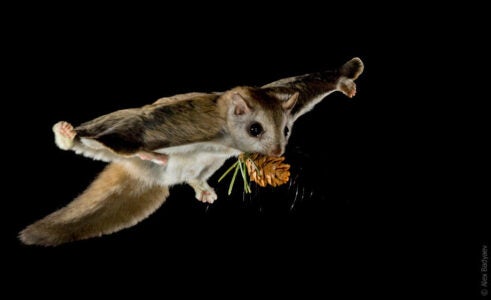Fun facts about the amazing flying squirrel
Published 1:58 pm Wednesday, August 21, 2024
|
Getting your Trinity Audio player ready...
|
Did you know that Western North Carolina is home to some of nature’s most incredible acrobats? They’re not circus performers but tiny, furry creatures that can glide through the air like superheroes. We’re talking about flying squirrels!
Now, before you start looking up at the sky, hoping to spot one, let’s clear something up. Flying squirrels don’t actually fly like birds or bats. Instead, they’re master gliders. They have a special flap of skin called a patagium that stretches from their wrists to their ankles. When they spread their legs out, this skin acts like a glider, letting them soar between trees.
In Western North Carolina, we’re lucky to have two different kinds of these nighttime daredevils. First, there’s the northern flying squirrel, which is about the size of a chipmunk and has big, dark eyes that help it see at night. Then we have the southern flying squirrel, which is even smaller—about as big as a mouse! And at higher elevations (above 4,000 ft), you might see the Carolina northern flying squirrel, an endangered subspecies.
Trending
Flying squirrels are nocturnal, meaning they’re most active at night. If you’ve ever been camping and heard strange chirping sounds after dark, you might be listening to flying squirrels talking to each other!
These amazing animals can glide really far—-up to 160 feet in a single leap! That’s longer than a whole basketball court. Pretty cool.
Flying squirrels have some other superpowers. Their tails act like rudders, helping them steer as they glide. And when they land on a tree trunk, they always do it heads-up. They’re so good at gliding they can even make sharp turns in mid-air to avoid predators or obstacles.
Here’s something even cooler—flying squirrels glow pink in the dark! When you shine an ultraviolet light on them, their fur gives off a bright pink glow called biofluorescence. No one knows why they glow, but it might help them recognize each other at night or confuse predators. It’s like they have their own built-in glow sticks!
Flying squirrels aren’t just incredible—they’re also super important for our forests. These little creatures love to eat all sorts of things, including nuts, seeds, fruits, and insects. When they hide seeds and nuts for later use, they often forget where they buried them. These forgotten seeds grow into new trees, helping the forest stay healthy.
Flying squirrels also help spread fungi through the forest. They eat mushrooms and then spread the spores in their poop as they glide around. When we teach kids about wildlife, they always get engaged when we mention poop!
Trending
Spreading fungus spores is important for the health of the trees and the whole forest ecosystem. Why? Trees use the fungi as a source of water, while the fungi use the trees as a source of sugar.
These night gliders are food for other animals, like owls, hawks, weasels, and even snakes, making them an important part of the forest food chain. Of course, things like climate change and the loss of their forest homes make life tough for all animals. That’s why it’s so important to protect our forests and the creatures that live in them.
So, next time you’re out in the woods at night, keep your eyes peeled and your ears open. You might just spot or hear one of these amazing gliders zooming from tree to tree. Nature is full of incredible surprises, like flying squirrels. There’s so much wonder and awe waiting to be discovered right in our own backyards. So get out there and explore! Every time you step into nature, you enter a magical world.

Flying squirrels don’t really fly! (Photo by Alexander Badyaev)
Loti Woods is co-founder of Champions for Wildlife, a local nonprofit organization whose mission is to inspire kids to be champions for wildlife through the power of art and education. To learn more, visit www.championsforwildlife.org.






